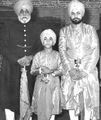Kaithal
| Author:Laxman Burdak, IFS (R) |
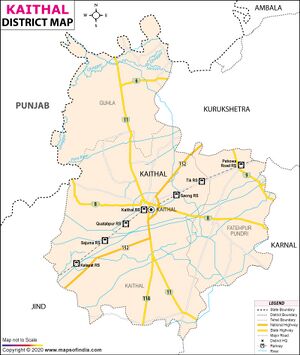
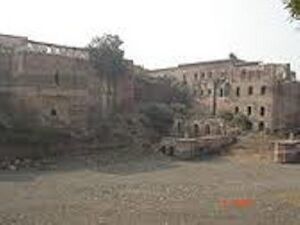
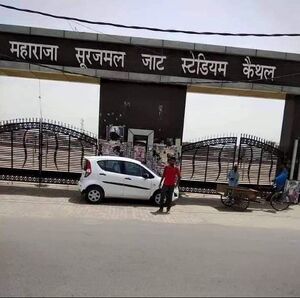
Kaithal (कैथल) is city and district in Haryana.
Origin
Its ancient name was Kapisthala (कपिस्थल ).[1]
Variants
- Kaithal (कैथल) = Kapishthala (कपिष्ठल) (AS, p.226)
- Kapishthala (कपिष्ठल) = (कपिस्थल) (AS, p.136)
- Avisthala (अविस्थल) = Kapisthala (कपिस्थल) = Kaithal (कैथल), हरयाणा (AS, p.48)
- Cambisthaloi (कंबिस्थलोई) (Arrian)
Founders
Modern Kaithal was founded by descendants of Desu Singh of Bidar- Jat clan.
It was earlier a part of district Karnal and in 1973 became part of the newly created district of Kurukshetra. Kaithal became a new district of Haryana on 1st November, 1989. The district headquarters is situated in Kaithal town. Other smaller towns of the district are Guhla, Pundri and Cheeka. The total area of Kaithal district is 2,389 sq km and its population is 8,20,000. Kaithal is known for intensive cultivation of Rice and Wheat with a well developed irrigation infrastructure.
Mention by Panini
Kapisthala (कपिस्थल) is mentioned by Panini in Ashtadhyayi. [2]
Kapisthala Katha (कपिस्थल कठ) is mentioned by Panini in Ashtadhyayi. [3]
V S Agarwal[4] mentions....Kapisthala (कपिस्थल) (VIII.3.91), modern Kaithal in Karnal district.
Tahsils in Kaithal district
Villages in Kaithal tahsil
Barela, Ahmedpur, Ahun, Andhli, Atela, Badhnara, Badsikri Kalan, Badsikri Khurd, Bakal, Balu, Balwanti, Bandrana, Barot, Barsana, Batta, Begpur, Bhalang, Bhamniwala Urf Rajpura, Bhana, Bhanpura, Bheni Majra, Bidkhdalwa, Bir Bangran, Buchi, Budha Khera, Chandana, Chandlana, Chhot, Chuhar Majra, Chusala, Dadwana, Dawal, Deeg, Deoban, Deohera, Dhand, Dheraru, Dhodh Kheri, Dhondhwa, Dhos, Dhunderheri, Diluwala, Dohar, Doliani, Dosain, Dubal, Dumara, Fariabad, Farsh Majra, Fatehpur, Ferozepur, Franswala, Garhi Padla, Geong, Guhna, Guliana, Habri, Hajwana, Hari Pura, Harsola, Jadola, Jagdishpura, Jajanpur, Jakholi, Jamba, Jaswanti, Jatheri, Julani Khera, Kachhana, Kailram, Kaithal (M Cl), Kakot, Kala Sher, Kalayat (MC), Kamalpur, Karora, Kaasan, Kathana, Kathwar, Kaul, Keorak, Khanoda, Khanpur, Kharak Pandwan, Kheri Lamba, Kheri Matarwa, Kheri Raiwali, Kheri Raowali, Kheri Sakra, Kheri Sherkhan, Kheri Sheru, Kheri Sikander, Kheri Simbalwali, Khurana, Kole Khan, Kotra, Kukar Kanda, Kultaran, Kurar, Kutabpur, Ladana Baba, Lander Keema, Lander Peerzada, Magho Majri, Mahal Kheri, Majra Nand Karan, Majra Rohera, Malakpur, Manas, Mandhwal, Manjhlan, Mator, Meoli, Mohna, Mundhri, Munerheri, Naina, Nandsinghwala, Narar, Narwal Karnal, Nawach, Pabla, Pabnawa, Padla, Pai, Patti Afgan, Patti Dogran, Patti Khot, Peoda, Pharal, Pilni, Pinjupura, Pobala, Pundri (MC), Pundri, Rajaund, Ramana Ramani, Ramgarh Pandwan, Rasina, Rasulpur, Rawan Hera, Rohera, Roherian, Sajooma, Sakra, Salimpur Mehdud, Sanch, Sangatpur, Sangatpura, Sanghan, Sangri, Sangroli, Santokh Majra, Sapan Kheri, Saran, Seend, Sega, Serhada, Serta, Sher Garh, Simla, Sirsal, Sisla Sismore, Siwan, Sohlu Majra, Songal, Taragarh, Teek, Teontha, Theh Bahri, Titram, Ujana, Wazir Nagar,
History
V. S. Agrawala[5] writes that Ashtadhyayi of Panini mentions janapada Kuru (कुरु) (IV.1.172) - It was known to Panini as a janapada and a Kingdom. Hastinapura (VI.2.101) was its capital. The region between triangle of Thanesar, Hisar and Hastinapur was known by three different names. Kururashtra proper between Ganga River and Yamuna with its capital Hastinapur; Kurujangala equal to Rohtak, Hansi, Hisar; and Kurukshetra to the north with its centres at Thaneswar, Kaithal, Karnal.
V. S. Agrawala[6] writes that Panini mentions that The ending sthala occurs in Kapisthala (VIII.3.91) modern Kaithal in Karnal district. Alternately sthali (IV.1.42) was also in use.
Formerly, Kaithal was known as 'Kapisthala' (कपिस्थल), or 'Abode of Monkeys'. Vaman Purana says : "Kapisthaleti vikhyatam sarvapatakanashanam yasmina sthitaha swayam devovridha kedara samgjijitaha"
Meaning: The destroyer of all devilish deeds, the famous Kapisthala sanctum is here because Lord Vridhakedara himself resides in it.
It is also believed that the city was founded by Pandu putra Yudhisthira. According to Hindu mythology, Lord Krishna had constructed nine kunds to appease the 'navgrahas' of the Pandavas during the Mahabharata war. King Yudhishthir is believed to have prayed with Lord Krishna here.
Modern Kaithal was founded by descendants of Desu Singh of Bidar Jat clan.
In 1767, it fell into the hands of the Sikh chieftain, Bhai Desu Singh, whose descendants, the Bhais of Kaithal, ranked among the most powerful Cis-Satlej states. Their territories lapsed to the British in 1843. There exist remains of the fort of the Bhais, and several Muslim tombs of the 13th century and later. The temple dedicated to Anjana (mother of Hanuman) is another historic place at Kaithal.
Razia Sultana, the first woman ruler of Medieval India, was killed near Kaithal.
The new minister at Dehli and his campaign AD 1779:
Lepel H. Griffin writes: [7] Nawab Majd-ud-doulah Abd-ul-ahd was now minister at Delhi. He was an ambitious and covetous man and was not destitute of ability ; but he had little courage, and it was audacity alone which, in the last days of the Empire, could command success. He determined, however, to make an effort to recover the Malwa country from the Sikhs, and set out from Dehli, in November 1779, with a considerable force and accompanied by Prince Farkhunda Bakht. He reached Karnal without meeting any resistance and here was joined by Sirdar Bhagel Singh Krora Singhia ; * Sahib Singh Khundawala and Karam Singh Shahid. The envoys of Bhai Desu Singh Kythal had accompanied the Nawab from Dehli, and there is little doubt that this Chief hoped, by early submission, to gain the favor of the Imperial party and obtain an advantage over his rival, Amar Singh of
[Page-51]: Pattiala, whom he would have been delighted to crush. But in this he was totally disappointed. The Nawab much wished to reconquer the Malwa territory, but he wanted more; and Bhai Desu Singh was reputed to be rich.
Bhai Desu Singh fined:
On a charge of not having paid his arrears of revenue he was seized, and four lakhs of rupees were demanded from him as a fine. Of this he contrived to pay three lakhs ; and for the payment of the balance, he gave his son Lai Singh as a hostage.*
- * The Kythal family was of so much importance in the Cis-Satlej States, and their history is so closely connected with that of Pattiala, that a sketch of it is essential here. The genealogy of the family is as follows :—
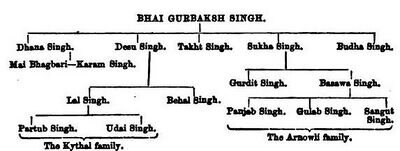
- The Kythal family have the same origin as the Phulkian. Gurbuksh Singh, the founder of the Chiefship, was the son of Bhai Ramdyal, who had a great reputation as a saint. The son was a fine soldier and an able man, but he had little of the saint about him, and thought more of annexing territory than of religion. He was a great friend of Raja Ala Singh of Pattiala, and they made many expeditions together, and he helped the Raja out of more than one difficulty. The possessions of Gurbuksh Singh were divided among his sons ; but they soon increased them. Desu Singh captured Kythal from some Afghans, Bhikh Baksh Khan and Nihmat Khan, and, with his brother Budha Singh, seized Thanesar, though the town and fort were afterwards taken from them by Sirdar Bhanga Singh, the fiercest and most feared of all the Cis-Satlej chiefs. When Desu Singh died in 1781, Lal Singh was in confinement as a rebel against his father, and Behal Singh, the elder son, did all he could to keep his brother in prison ; but he contrived to escape, killed his elder brother and took possession all the estates of his father, which he much enlarged by new acquisition. Lal Singh was, at the time of the British advance northwards, in 1809, the most powerful Cis-Satlej Chief, after the Raja of Pattiala. He was a very' able man, though utterly untrustworthy, and so violent and unscrupulous that the English authorities had the greatest difficulty in persuading him to maintain
[Page-52]: anything like order. In 1819, the Government allowed him to succeed to the share of the estate held by Mai Bhagbari, the widow of his first cousin Karam Singh. Partab Singh the elder son and then the younger son, Udai succeeded, but on the death of the latter without issue in 1843, the whole of the Kythal estate lapsed to Government, with the exception of that portion which had been acquired by the founder of the family, Bhai Gurbuksh Singh, and to which the collaterals of the Arnowli branch were permitted to succeed.
कपिस्थल - कपिष्ठल
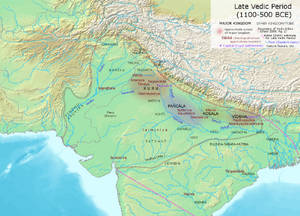
विजयेन्द्र कुमार माथुर[8] ने लेख किया है ...कपिष्ठल (AS, p.136) वर्तमान कैथल करनाल ज़िला, हरियाणा में है। किंवदंती में इस स्थान का संबंध हनुमान् से जोड़ा गया है। पाणिनि (8,2,91) में इसका उल्लेख है। महाभारत में वन पर्व के अंतर्गत उल्लिखित तीर्थों में इसकी गणना की गई है। उद्योग पर्व महाभारत 31, 19 के एक पाठ के अनुसार कपिस्थल उन पांचों ग्रामों में था जिन्हें पांडवों ने कौरवों से युद्ध रोकने का प्रस्ताव करते हुए मांगा था- 'कपिस्थलं वृकस्थलं माकन्दीं वारणावतम्, अवसानं भवत्यत्र किंचिदेकं च पंचमम्'। अन्य पाठ में कपिलस्थल के स्थान पर अविस्थल है जिसका अभिज्ञान अनिश्चित है। अलबेरूनी ने कपिस्थल को कवितल लिखा है। (अलबेरूनी 1,206) एरियन ने इसे कंबिस्थलोई कहा है।
The esceat of Kythal and the action of Raja of Jhind
Lepel H. Griffin[9] writes....Raja Sarup Singh did not abandon hope of obtaining the whole of the possessions which had been held by his predecessors, and several times addressed the Government without success. The escheat of Kythal, in March 1843, furnished him with another argument, for although the lapse of this territory was made on the principle which had regulated the Jhind succession, viz., that a collateral descendant should inherit so much only of the territory as was possessed by the ancestor from whom he derived his claim ; yet, on a former occasion, the Kakrila estate, which was a portion of Kythal, had been allowed to pass collaterally without regard to any such considerations : and, accordingly, both Raja Sarup Singh and Maharaja Karam Singh of Pattiala tried their best to obtain a recognition of the full right of succession of the second cousin of the late Bhai of Kythal, believing that if this were once allowed, the right of Sarup Singh to the whole of the Jhind territory would be likewise admitted.* In this expectation, however, they were disappointed. The Government had made in the Jhind succession case quite as many concessions as they considered just, and on the same principle Kythal was resumed. The three Phulkian Rajas intrigued against this decision as long as was possible, and their sympathy and secret advice encouraged a rebellion at Kythal, which was only put down after some bloodshed. Yet, when the insurrection had fairly broken out, they gave every assistance in suppressing it, and
1886. Agent Governor General Dehli to Political Agent, 6th July 1837. Mr. Clerk to Sir C. Metcalfe, 10th November 1835.
* Maharaja Karam Singh to Agent Governor General, 29th September 1844, Raja Sarup Singh to Agent Governor General, 5th October 1844.
their troops captured and dispersed several parties of the rebels.*
Jhind obtains a portion of the Kythal territory by exchange:
Of the resumed Kythal territory, a pargannah, Mahala Gabda, was given to the Raja of Jhind, in exchange for a portion of Sufidon, the former consisting of 23 villages, worth Rs. 30,042 a year, and the latter consisting of 38 villages, worth Rs 33,380. The difference was calculated on the eventual lapse of rent-free lands, the quality of soil and the depth of water, in which particulars Mahala was more fortunate than Sufidon. The village of Sufidon itself was excluded from the transfer, as it was a place of pilgrimage, and a favorite hunting seat of the Raja of Jhind, containing, moreover, the cenotaphs of the family.†
* Mr. Clerk to Government of India, 30th March. Mr. Greathed, Secretary of Legation to Mr. Clerk, 27th March, and to Raja Sarup Singh, 24th March. Mr. Clerk to Government of India, 8th April. Mr. Greatbed to Mr. Clerk, 29th March. Mr. Clerk to Government, 25th April. Maharaja of Pattiala to Mr. Clerk, 18th April 1843. Raja of Jhind to Governor General, 5th October 1844.
† Major H. Lawrence, Assistant Envoy, to Mr. Clerk, 11th May 1843, and 9th July 1843. Colonel Richmond to Government North Western Provinces, 1st August 1843.
अविस्थल
विजयेन्द्र कुमार माथुर[10] ने लेख किया है कि....अविस्थल (AS, p.48): अविस्थल महाभारत उद्योग पर्व 13-19 में उल्लिखित पांच स्थानों में से एक जिन्हें युधिष्ठिर ने दुर्योधन से पांडवों के लिए मांगा था. उन्होंने यह संदेश दुर्योधन के पास संजय द्वारा भिजवाया था--'अविस्थलंवृकस्थलं माकन्दीं वारणावतम्, अवसानं भवत्वत्र किंचिदेकं च पञ्चमम्' Mahabharata (V.31.19) अर्थात हमें केवल अविस्थल, वृकस्थल, माकन्दी, वारणावत तथा पांचवा कोई भी ग्राम दे दें. वृकस्थल या वृकप्रस्थ (वर्तमान बागपत, माकन्दी और वारणावत (वर्तमान बरनावा, जिला मेरठ, उत्तर प्रदेश) हस्तिनापुर के निकट ही स्थित थे. अविस्थल भी इन के निकट ही होगा यद्यपि इसका ठीक-ठीक अभिज्ञान संदिग्ध है. कुछ विद्वानों के अनुसार अविस्थल का शुद्ध पाठ कपिस्थल या कपिष्ठल होना चाहिए. कपिस्थल वर्तमान कैथल है.
माकन्दी = आसन्दी (Mahabharata) (V.31.19)
सिद्धू - बराड़ जाटवंश
दलीप सिंह अहलावत [11] के अनुसार ये दोनों जाटवंश (गोत्र) चन्द्रवंशी मालव या मल्ल जाटवंश के शाखा गोत्र हैं। मालव जाटों का शक्तिशाली राज्य रामायणकाल में था और महाभारतकाल में इस वंश के जाटों के अलग-अलग दो राज्य, उत्तरी भारत में मल्लराष्ट्र तथा दक्षिण में मल्लदेश थे। सिकन्दर के आक्रमण के समय पंजाब में इनकी विशेष शक्ति थी। मध्यभारत में अवन्ति प्रदेश पर इन जाटों का राज्य होने के कारण उस प्रदेश का नाम मालवा पड़ा। इसी तरह पंजाब में मालव जाटों के नाम पर भटिण्डा, फरीदकोट, फिरोजपुर, लुधियाना आदि के बीच के प्रदेश का नाम मालवा पड़ा। (देखो, तृतीय अध्याय, मल्ल या मालव, प्रकरण)।
जब सातवीं शताब्दी में भारतवर्ष में राजपूत संघ बना तब मालव या मलोई गोत्र के जाटों के भटिण्डा में भट्टी राजपूतों से भयंकर युद्ध हुए। उनको पराजित करके इन जाटों ने वहां पर अपना अधिकार किया। इसी वंश के राव सिद्ध भटिण्डा नामक भूमि पर शासन करते-करते मध्य भारत के सागर जिले में आक्रान्ता होकर पहुंचे। इन्होंने वहां बहमनीवंश के फिरोजखां मुस्लिम शासक को ठीक समय पर सहायता करके अपना साथी बना लिया था जिसका कृतज्ञतापूर्वक उल्लेख शमशुद्दीन बहमनी ने किया है। इस लेखक ने राव सिद्ध को सागर का शासनकर्त्ता सिद्ध किया है। राव सिद्ध मालव गोत्र के जाट थे तथा राव उनकी उपाधि थी। इनके छः पुत्रों से पंजाब के असंख्य सिद्धवंशज जाटों का उल्लेख मिलता है। राव सिद्ध अपने ईश्वर विश्वास और शान्तिप्रियता के लिए विख्यात माने जाते हैं। राव सिद्ध से चलने वाला वंश ‘सिद्धू’ और उनकी आठवीं पीढ़ी में होने वाले सिद्धू जाट गोत्री राव बराड़ से ‘बराड़’ नाम पर इन लोगों की प्रसिद्धि हुई। राव बराड़ के बड़े पुत्र राव दुल या ढुल बराड़ के वंशजों ने फरीदकोट और राव बराड़ के दूसरे पुत्र राव पौड़ के वंशजों ने पटियाला, जींद, नाभा नामक राज्यों की स्थापना की। जब पंजाब पर मिसलों का शासन हुआ तब राव पौड़ के वंश में राव फूल के नाम पर इस वंश समुदाय को ‘फुलकिया’ नाम से प्रसिद्ध किया गया। पटियाला, जींद, नाभा रियासतें भी फुलकिया राज्य कहलाईं। बाबा आला सिंह संस्थापक राज्य पटियाला इस वंश में अत्यन्त प्रतापी महापुरुष हुए। राव फूल के छः पुत्र थे जिनके नाम ये हैं - 1. तिलोक 2. रामा 3. रुधू 4. झण्डू 5. चुनू 6. तखतमल। इनके वंशजों ने अनेक राज्य पंजाब में स्थापित किए।
जाट वीरों का इतिहास: दलीप सिंह अहलावत, पृष्ठान्त-774
फुलकिया से सम्बन्धित कैथल और अरनौली राज्य थे। इनके अतिरिक्त भदौड़, झुनवा, अटारी आदि छोटी-छोटी रियासतें भी सिद्धू जाटों की थीं। यही वंश पंजाब में सर्वाधिक प्रतापी है और सम्पूर्णतया धर्म से सिक्ख है।
राव सिद्धू के पुत्र राव भूर बड़े साहसी वीर योद्धा थे। अपने क्षेत्र के भट्टी राजपूतों से इसने कई युद्ध किए। इसी तरह से राव भूर से सातवीं पीढ़ी तक के इस सिद्धूवंश के वीर जाटों ने भट्टी राजपूतों से अनेक युद्ध किए। भट्टी राजपूत नहीं चाहते थे कि हमारे रहते यहां कोई जाट राज्य जमे या जाट हमसे अधिक प्रभावशाली बनकर रहें किन्तु राव सिद्धू की आठवीं पीढ़ी में सिद्धू गोत्र का जाट राव बराड़ इतना लड़ाकू शूरवीर, सौभाग्यशाली योद्धा सिद्ध हुआ कि उसने अपनी विजयों द्वारा राज्यलक्ष्मी को अपनी परम्परा में स्थिर होने का सुयश प्राप्त किया। यहां तक कि फक्करसर, कोट लद्दू और लहड़ी नामक स्थानों पर विजय प्राप्त करने पर तो यह दूर-दूर तक प्रख्यात हो गया। राव बराड़ के नाम पर सिद्धूवंशज बराड़वंशी कहलाने लगे। आजकल के सिद्धू जाट अपने को बराड़वंशी कहलाने में गौरव अनुभव करते हैं। इस वीर योद्धा राव बराड़ के दो पुत्र थे। बड़े का नाम राव दुल (ढुल) और छोटे का नाम राव पौड़ था।
इन दोनों की वंशपरम्परा में पंजाब में निम्न राज्य स्थापित किए ।
कैथल का भाई खानदान:बिड़ार-वंशी जाट
ठाकुर देशराज लिखते हैं कि जिस समय सिख-धर्म के प्रवर्तक गुरुनानक (1469 – 1539) इस संसार से विदा हो गए तो उनके बाद अंगदजी गुरु हुए। अंगदजी के पश्चात् अमरदास और फिर रामदास गुरु की श्रेष्ठ पदवी से विभूषित हुए। जिस समय गुरु रामदास जी को गद्दी दी गई थी, उस समय गद्दी देते हुए अमरदासजी ने रामदासजी से एक कार्य करने के लिए कहा था। वह कार्य यह था कि तुंग, सुल्तान पिंड और गुमटाला नामक गांवों के बीच में कई कोस का एक जंगल था। उस जंगल में एक बहुत पुराना तालाब था किन्तु वह मिट्टी से भरा हुआ था। गुरुजी उसे खुदवाकर फिर से जलाशय बनाना चाहते थे। गुरु अमरदासजी रामदासजी को लेकर उस स्थान पर पहुंचे भी। चूंकि वह जगह जाटों की सम्मिलित भूमि थी, इसलिए गुरुजी ने आस-पास के मुख्य-मुख्य जाटों को बुलवाकर उस भूमि को मांगा। जाटों ने जब सुना कि गुरुजी इस स्थान पर निरन्तर पानी रखने वाला तालाब खुदवाना चाहते हैं तो उन्होंने वह जमीन गुरुजी को दे दी। जगह मिलने पर आषाढ़ संवत् 1929 (? 1629) वि० को उस स्थान पर गुरु रामदासजी के हाथ से एक नगर और सरोवर की बुनियाद डलवाई।
उस समय गुरु लोगों की कोई भारी शक्ति न थी। वे अपने उपदेशों से अपना सम्प्रदाय बढ़ाया करते थे। रामदासजी के भी आस-पास अनेक हिन्दू और विशेषतया जाट शिष्य हो गए। इन्हें जाट शिष्यों में एक भाई भगतू थे। यह बिड़ार-वंशी जाट थे। इनके पिता का नाम ओम् था। भगतूजी इतने ईश्वर-भक्त और गुरु-भक्त थे कि लोग उनके असली नाम को भूल गए और वे भगतू के नाम से ही मशहूर हो गए। रामदासजी इस चिन्ता में थे कि तालाब किस भांति खुदे। उनके पास कोई साधन न था। ओम् गुरुजी की इस चिन्ता से दुःखी हुए, किन्तु वह भी कोई वैभव सम्पन्न व्यक्ति न थे। हां, उनके पास साहस था इसलिए वह स्वयं
जाट इतिहास:ठाकुर देशराज, पृष्ठान्त-510
तालाब खोदने में लग गए। और भी कुछ मनुष्य तालाब की खुदाई करते थे किन्तु वे मजदूरी लेते थे। ओम् धार्मिक कृत्य समझकर खोदते थे। गुरु रामदासजी ओम् की भक्ति से बहुत प्रसन्न हुए और आशीर्वाद दिया कि तेरा पुत्र बड़ा प्रतापी होगा। दैवयोग से बात ऐसी ही हुई। ओम् के सुपुत्र भगतू के नाम से आज सारा पंजाब परिचित है।
गुरु रामदासजी की मृत्यु के पश्चात् गुरु अर्जुन गद्दी पर विराजे। भगतू ने सिख धर्म की और गुरुजी की बहुत सेवाएं कीं। समस्त सिख भगतू को श्रद्धा की दृष्टि से देखते हैं।
भगतू के सम्बन्ध में एक बड़ी विचित्र बात कही जाती है। गुरु हरिराम ने इनसे कहा कि तुम मेरे ही सामने शरीर छोड़ दो। भगतू ने यह बात मान ली और करतारपुर में जो कि इलाका जालन्धर में है, पृथ्वी में समा गया। कुछ काल बाद गुरु हरीराम उधर से फिर गुजरे। भगतू की समाधि के पास आकर कहने लगे कि ऐ सिख वीर भगतू! हमें दर्शन दे। भगतू गुरु की इस बात को सुनकर समाधि में से जिन्दा निकल आए। गुरुजी से वार्तालाप करने के बाद फिर समाधि में समा गए। गुरु ने आशीर्वाद दिया कि तुम्हारी संतान के लोग वैभवशाली और राजा होंगे।
भगतू का खानदान भाई के नाम से भी मशहूर है। इसका कारण यह बताया जाता है कि गुरु अर्जुन ने भगतू की भक्ति से प्रसन्न होकर भाई की उपाधि दी। भगतू के दो बेटे हुए - संतदास और गोरा।
संतदास, जिसका कि दूसरा नाम जीवनसिंह भी था, की औलाद के लोग भटिण्डा की ओर चले गये और वहां जाकर उन्होंने राज्य स्थापित कर लिया।
गोरा की संतान के लोगों ने कैथल और दूनोली के परगने को अपने कब्जे में कर लिया और राजा बन बैठे।
गोरा के महासिंह, किशनसिंह, माईदास और दयालसिंह नाम के चार पुत्र हुए। जिसमें किशनसिंह, महासिंह की संतान के लोग भटिंडा की ओर चले गए और माईदास निःसन्तान मर गए।
भाई दयालसिंह के छः पुत्र हुए। उनके सुक्खासिंह, धनसिंह, गुरुदाससिंह, देसूसिंह, बुद्धासिंह और बख्तसिंह नाम रखे गये थे।
सुक्खासिंह के दो पुत्र हुए - विसावासिंह और गुरुदत्तसिंह।
उनसे छोटे भाई धनसिंह के कर्मसिंह और चड़तसिंह नामक पुत्र हुए।
लालसिंह और सुजानसिंह नाम के दो पुत्र देसूसिंह के हुए।
बुद्धासिंह के कोई संतान न थी। बख्तसिंह के दालसिंह नाम का एक ही पुत्र हुआ।
कैथल पर अधिकार देसूसिंह की संतान का था। लालसिंह उनका बड़ा पुत्र कैथल का राजा था। उसके राज्य की आमदनी चार लाख थी।
सुक्खासिंह के पुत्र विसावासिंह के पास भी बीस गांव थे।
लालसिंह के दो पुत्र हुए - उदैसिंह और प्रतापसिंह। दोनों ही निःसन्तान मर गये। लालसिंह की मृत्यु संवत् 1901 विक्रमी अर्थात् 1846 ई० में हो गई। इस समय तक महाराज रणजीतसिंह पंजाब
जाट इतिहास:ठाकुर देशराज, पृष्ठान्त-511
केसरी का स्वर्गवास हो चुका था और लाहौर की गद्दी पर नाटक हो रहा था।
उदैसिंह के पश्चात् उसकी रानी महताबकुंवरि राज्य की मालिक बनीं। वह बड़ी वीर प्रकृति की थी और अंग्रेजों से भी लड़ बैठी। अंग्रेजों की शक्ति के मुकाबले में बेचारी क्या कर सकती थी, हार निश्चित थी। सेना तितर-बितर हो गई। फिर भी आपके दिल में आशा था, अतः आप मैदान से निकल भागीं। सेना इकट्ठी करने लगी। किन्तु अंग्रेजी सेना ने आपको पकड़ लिया। उसका कैथल राज्य जब्त कर लिया गया।
उदैसिंह ने भाई विसावासिंह को गोद लिया पुत्र बना लिया था। सरकार ने उसको चौबीस हजार सालाना का इलाका दे दिया और रानी महताबकुंवरि की बीस हजार वार्षिक की पेन्शन कर दी। इसी बीस हजार में से उदैसिंह के भानजे चूहड़सिंह को भी रानी साहिबा को देना पड़ता था। पोदा नाम के गांव में आपके रहने के लिए स्थान नियुक्त हुआ। इस स्थान पर उदैसिंह जी की बनाई एक कोठी थी जिसमें पत्थर का बहुत ही अच्छा काम किया गया था। पीछे से यह स्थान अंग्रेजी इलाके में मिला लिया गया। विसावासिंह और उसके पुत्र अरनोली में रहने लगे। संगतसिंह और उनकी संतान के लोग इलाका सिद्धूवाल के अधिकारी रहे।
Jat Gotras in Kaithal
Places to visit
Notable persons
- Bhai Lal Singh -
- Bhai Dhanna Singh and Sukha Singh of Kythal ; and Bhai Desu Singh, the father of the famous Lal Singh whose power later became too formidable to Pattiala. (Punjab Chief,p.39).
- Bhai Udey Singh of Kythal died on the 15th of March 1843.
External links
Gallery
-
Bhai Shri Fateh Jang Singh of Kaithal-Kunwar Amar Jang Singh (Mid) & Bhai Babar Jang Singh of Kaithal (Right)
-
Raja Bhai Fateh Jang Singh of Kaithal with Dr. Rajinder Parsad president of India over tea .
-
Raja Bhai Fateh Jang Singh of Sidhowal. Descendants of Maharaja Bhai Uday Singh of Kaithal. Source - Jat Kshatriya Culture
References
- ↑ Mahipal Arya, Jat Jyoti, August 2013,p. 15
- ↑ V. S. Agrawala: India as Known to Panini, 1953, p.65, 71
- ↑ V. S. Agrawala: India as Known to Panini, 1953, p.323
- ↑ V S Agarwal: India as Known to Panini, p.71, sn. 17.
- ↑ V. S. Agrawala: India as Known to Panini, 1953, p.54
- ↑ V. S. Agrawala: India as Known to Panini, 1953, p.65
- ↑ The Rajas of the Punjab by Lepel H. Griffin/The History of the Patiala State ,p.50-51
- ↑ Aitihasik Sthanavali by Vijayendra Kumar Mathur, p.136
- ↑ The Rajas of the Punjab by Lepel H. Griffin/The History of the Jhind State,pp.383-84
- ↑ Aitihasik Sthanavali by Vijayendra Kumar Mathur, p.48
- ↑ Jat History Dalip Singh Ahlawat/Chapter IX, pp. 774-775


